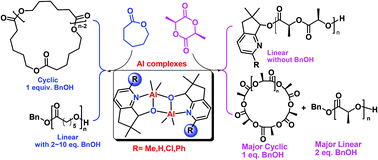Dialkylaluminum 2-substituted 6,6-dimethylcyclopentylpyridin-7-oxylates toward structural-differentiation of the ring-opening polymerization of ε-caprolactone and l-lactides†
Abstract
Herein, a series of dialkylaluminum 2-substituted 6,6-dimethylcyclopentyl pyridin-7-oxylates Al1–Al7 were synthesized and characterized by 1H- and 13C-NMR spectroscopy and elemental analysis. The molecular structure of Al3 was proven to be a dimer of an aluminum complex. These aluminum complexes could efficiently initiate the ring-opening polymerization (ROP) of ε-caprolactone (CL), and the structural differentiations of the resultant PCL were strongly dependent on the amount of BnOH (PhCH2OH) used. In the absence of BnOH, the resultant PCL showed a cyclic structure, whereas BnO-capped linear PCL was obtained in the presence of >2.0 equivalents of BnOH; the resultant PCL was a mixture of linear and cyclic PCLs in the presence of 1.0 equivalent of BnOH. Moreover, these aluminum complexes exhibited high efficiency towards the ROP of L-lactide (LLA); however, the activities were lower than those for the ROP of ε-CL. Without BnOH, the resultant PLLA showed a highly linear structure with the alkyl-end group from aluminum complexes; on the other hand, PLLA displayed a major cyclic structure and minor BnO-capped linear PLLA if 1.0 equivalent of BnOH was employed, and the percentage of BnO-capped linear PLLA was increased by increasing the amount of BnOH.



 Please wait while we load your content...
Please wait while we load your content...